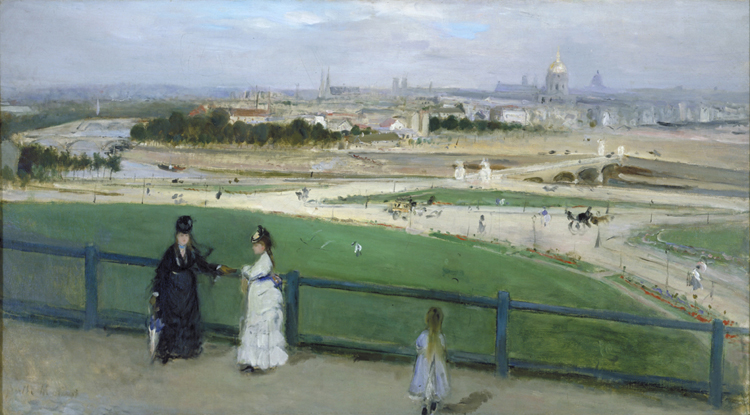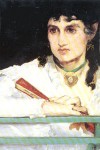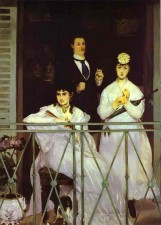
Berthe Morisot
French, 1841-1895
View of Paris from the Trocadero, 1872-1873
oil on canvas
18 1/16 x 32 1/16 in.
SBMA, Gift of Annie Lawrie Kirkland
1974.21

Morisot by Edouard Manet, detail from The Balcony, 1868-69.
"It is important to express oneself... provided the feelings are real and are taken from your own experience." - Berthe Morisot
RESEARCH PAPER
Paris Seen from the Trocadéro was painted in oil by Berthe Morisot (1841-1895) in about 1872. A product of her early impressionist style, it shows loose but confident brushstrokes, little delineation, and a conservative palette. The painting is in fine condition, having had conservation work performed on it by the Los Angeles County Museum of Art Conservation Center in 1976. At that time discolored varnish was removed, a small scratch in the lower left corner repaired, the surface cleaned, loose paint adhered and inpainted, and the surface revarnished.
PROVENANCE
Edouard Manet was more than favorably impressed with Morisot’s Trocadero. He had painted a similar view in 1867, which included the grounds of the Paris Exposition of that year. Her distinctive handling of the subject delighted him, and it was said that because of this Morisot presented him with the painting. There seems to be no record of such a transaction however. It was sold in 1876 to an eccentric millionaire, De Bellio, who was a supporter of the impressionists. Subsequently, it appeared in the collections of Donop deMouch, J. Doucet, and Joseph Ryerson. Ryerson’s widow, Annie Lawrie married Hugh Nesbit Kirkland, a New York banker, and they spent their winters in Santa Barbara at their home on Sycamore Canyon Drive. For many years Mrs. Kirkland loaned valuable paintings to the SBMA while she was away from the city. In 1974 she donated this painting to the Museum.
STYLE
Except for the few months spent in trips to Italy, England, Spain, and summers in small French villages, Berthe Morisot spent most of her adult life in the vicinity of the Place de Trocadéro. In fact, she is buried there in the Passy Cemetery. Morisot was born in Bourges, France in 1841 to a wealthy family, her father being an official of the French government as well as an architect. When Berthe was 13 the family moved to Paris. Two of the three Morisot daughters showed an aptitude for painting and were given private lessons by one Guichard, a popular painter who had studied under Delacroix and Inges. When Guichard realized that Berthe’s penchant for outdoor scenes was not compatible with his own taste, he introduced her and sister Edma to Camille Corot. For many years they watched Corot paint, copied his paintings and those in the Louve which he recommended. His influence is evident in Berthe’s treatment of the airy skyline atmosphere in Trocadéro. Corot introduced them to other prominent painters and soon a young artistic set of painters was meeting regularly at the Morisot home along with writers, musicians, and other artists who had previously frequented it.
In 1864 Berthe’s first paintings were accepted by the Salon of Paris, an achievement to be envied, as without the approval of the prestigious Salon, painters could not find dealers who would exhibit their work. Many days found Morisot in the Louve copying the masters, and it was here in 1867 that she was introduced to Edouard Manet who was to have a profound influence on her life. He was impressed with her beauty, the freshness and delicacy of her painting, and she was captivated by his charm. In 1868, with her mother as chaperone, she posed for him in one of his famous paintings, The Balcony, and became a willing subject for others. Their friendship was mutually beneficial: she demonstrated her treatment of the natural out-of-doors light while Manet liberated her brushstrokes to be freer, and more daring.
A strong minded woman, Morisot would not accept Manet’s advice to stay with the Salon and not exhibit with the impressionists in 1874. This same year she married Manet’s brother, Eugene. A true strength in the impressionist movement then thrusting it way onto the Paris art scene, Morisot felt that to break with the reactionary Salon and exhibit with Monet, Degas, Passarro, Renoir and over 20 others would help to advance its cause. Manet favored this new art form, in fact was its mentor, but he felt that the power of the Salon was too great to be challenged.
For the next ten years the impressionists held their own exhibitions with Morisot contributing every year except 1879 when she was ill from the birth of her only child. Slowly the impressionists began to break the hold of the reigning classicists. Morisot’s work continued to bloom, her palette becoming more brilliant, her brushstrokes more rapid and short. Her works were much appreciated by her artistic contemporaries who bought many of them, and in impressionist auctions her paintings consistently sold better and for more money. Many successful one person exhibits were held throughout Europe and also two in the United States. In 1894, a year before her death, the French government purchased Young Woman Dressing For A Ball for its Luxembourg Collection. Unlike most women of her day, art for Berthe Morisot was not a facet of a well-bred woman’s education, but a way of life – an extension of her very self.
CONTENT
Paris Seen from the Trocadéro was painted from a point above the Seine in the west of Paris. The foreground, the hill of Chaillot, contains three figures (the artist’s sisters and niece) with a strong diagonal fence line; the middle plane is the shallow valley of the Seine with the Pont D’Iena on the right across from which the Eiffel Tower was erected; and the third plane is the city of Paris skyline, the massive towers of Notre Dame being plainly visible.
The impact of the painting lies in its strong division into three planes, its treatment of light and atmosphere, and the deft strokes that determine figures with elusive clarity, giving them importance without emphasis. Critics have considered this painting to be Morisot’s first masterpiece.
Prepared for the SBMA Docent Council by June Mallozzi, April, 1986.
BIBLIOGRAPHY
Exhibition and Collection Catalogs:
Dixon Gallery and Gardens, Memphis, Tenn. Impressionists in 1877 12/4/77 -- 1/8/78
National Gallery of Art, Washington, D.C. Manet and Modern Paris, Theodore Reff, 1982, Wildenstein Gallery, New York, N. Y. 1960 Berthe Morisot
Slatkin Galleries, New York, N. Y., 1960 Berthe Morisot – Drawings/Pastels/Watercolors, Elizabeth Mongan (in collaboration)
St. Petersburg, FL Museum of Fine Arts “PHAROS, 1981 XVIII Berthe Morisot, A Woman Among Lunatics, Marion L. Grayson
Los Angeles County Museum of Art, A Day In the Country 1984
Books:
Rey, Jean Dominique. Berthe Morisot. Bonfini Press, Inc., Naefels, Switzerland, 1982
Rewald, John. The History Of Impressionism. Museum of Modern Art, New York, N.Y.
Wilenski, R. H. Modern French Painters. Reynal & Hitchcock, New York, N.Y.
POSTSCRIPT
The painting of Berthe Morisot is by Edouard Manet (1832-1883), French, The Balcony (detail), 1868-69, Oil on canvas, Musee d'Orsay.
"In the late 1860's another face appears in Manet's work, one of a remarkable and unusual intensity--that of Berthe Morisot. This young woman painter, to whom Fantin-Latour had introduced Manet at the Louvre many years earlier, contributed her ardent and melancholy beauty to The Balcony, an updated rendition of Goya's Majas on a Balcony of 1811.
Berthe Morisot--who in 1874 would become Manet's sister-in-law when she married his brother Eugéne--was a very fine painter, a student of Camille Corot's who was later strongly influenced by Manet and Renoir and would become one of the most active and faithful members of the Inpressionist group. Her charm and her intelligence, her talent as a painter, and her kind of wild beauty endeared her to Manet, and for many years she would remain one of his favorite portrait models, The fascination was mutual."
Françoise Cachin, Manet, The Influence of the Modern, Abrams, 1995. p.71-72.

The Balcony by Edouard Manet, 1868-69
SBMA CURATORIAL LABELS
Morisot lived near the Place du Trocadéro, a fashionable upper middle-class area of Paris, for
most of her adult life; the scene depicted here was one with which she was deeply familiar. The
influence of Morisot’s mentors, Camille Corot and Edouard Manet, can be felt in this airy
cityscape. Considered by critics to be her first masterpiece, this painting showcases her ability to
render light and atmosphere. Her deft brushwork, applied in confident, quick strokes, firmly
anchors the figures in the foreground. The wide, narrow format of the composition allows her to
generate the sensation of an expanse seen from a distance through a simple division of space into
horizontal bands.
- Ridley-Tree Reopening, 2021
